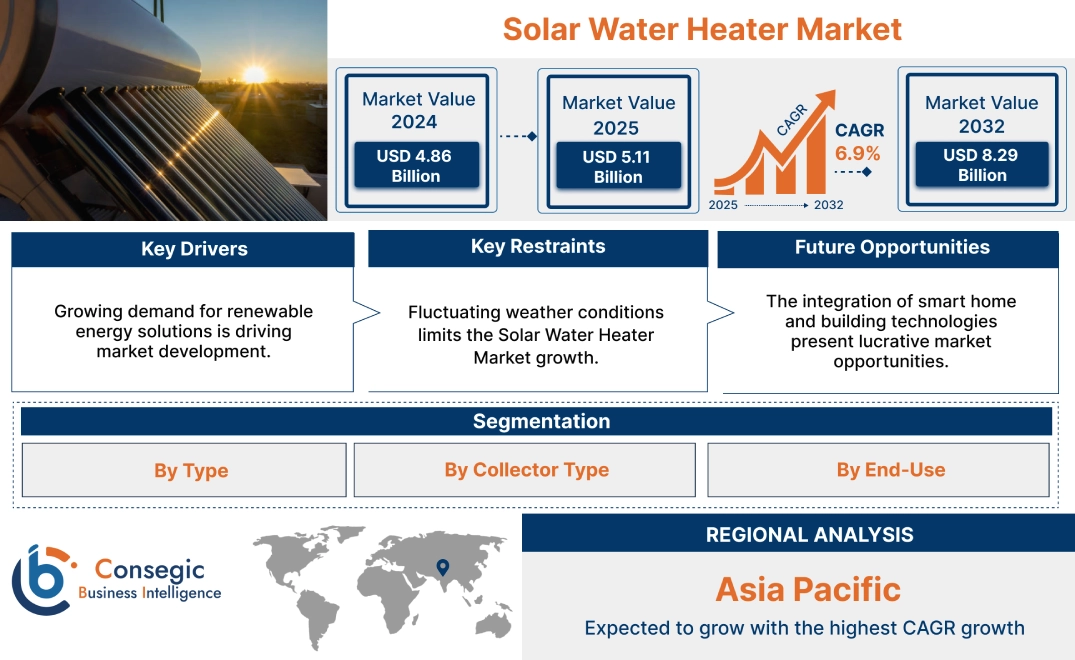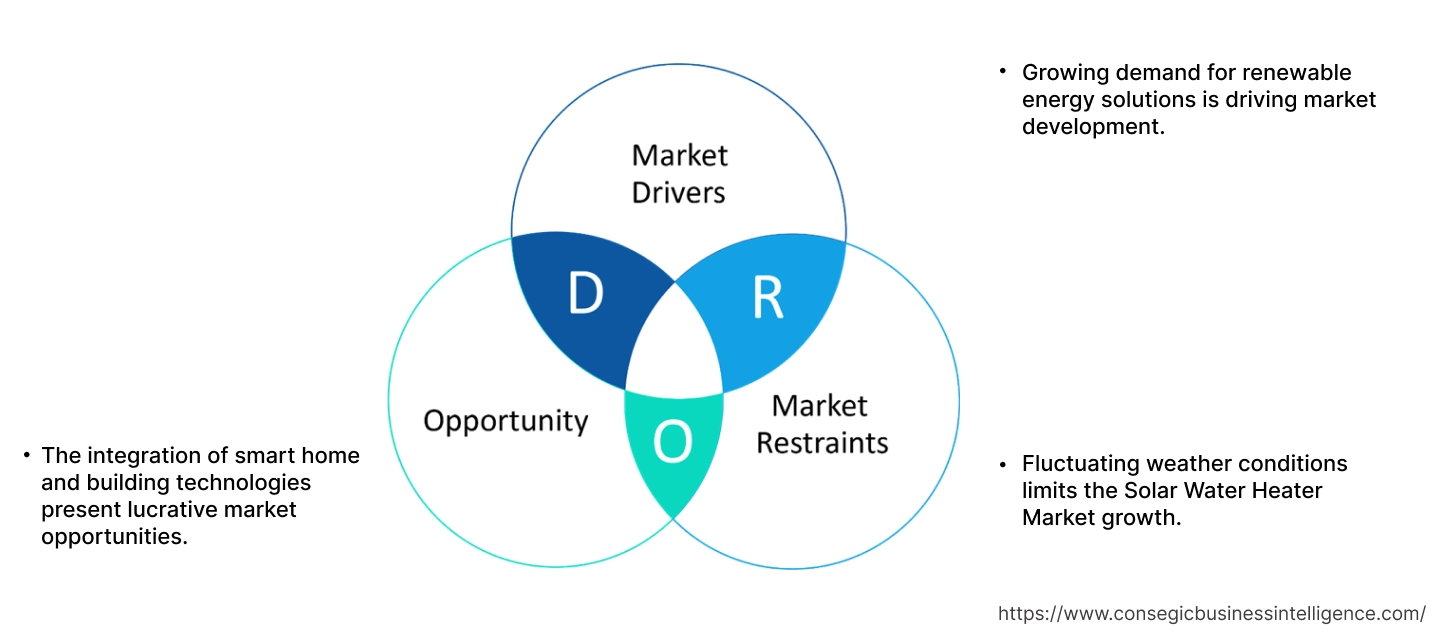Solar Water Heater Market Size:
Solar Water Heater Market size is estimated to reach over USD 8.29 Billion by 2032 from a value of USD 4.86 Billion in 2024 and is projected to grow by USD 5.11 Billion in 2025, growing at a CAGR of 6.9% from 2025 to 2032.
Solar Water Heater Market Scope & Overview:
A solar water heater is a thermal system that uses solar energy to heat water for residential, commercial, or industrial applications. These systems typically include solar collectors to capture sunlight, storage tanks to hold the hot water, heat exchangers, and circulation controls to move the water through the system. They are built to work effectively in different climates, using either direct or indirect methods to transfer heat from the sun to the water.
There are several types of systems depending on usage needs and water conditions. Common designs include flat plate collectors, evacuated tube collectors, and thermosiphon units. Each configuration varies in thermal efficiency, installation complexity, and maintenance requirements. Some systems also include backup heating units for days with little sunlight, and others use antifreeze in colder areas to keep the system from freezing.
This equipment helps reduce the use of electricity or fuel for heating water and supports energy-efficient operations. These systems are used in a variety of places including homes, hotels, food processing plants, and institutional buildings that need a steady and reliable supply of hot water.
Solar Water Heater Market Dynamics - (DRO) :
Key Drivers:
Growing demand for renewable energy solutions is driving market development.
The global emphasis on sustainability and reduced reliance on fossil fuels have fast-tracked the demand for renewable energy solutions like these water heaters powered by solar energy. These systems are considered one of the few energy-efficient and eco-friendly ways of heating water for domestic, commercial, and industrial use. Additionally, governments offer tax rebates, subsidies, and other financial incentives for solar technologies to induce the adoption of renewable energy technologies. This has made these water heaters more accessible and affordable, driving adoption in regions with abundant sunlight. Furthermore, as environmental concerns and the need to lower carbon footprints continue to grow, the appeal of these water heaters is strengthening. The mounting emphasis on renewable energy, alongside a few regions with increasingly supportive policies toward clean energy, is giving momentum to their acceptance, is significantly driving the solar water heater market demand.
Key Restraints:
Fluctuating weather conditions limits the Solar Water Heater Market growth.
The solar water heaters function in consistent sunlight, meaning their performance is heavily influenced by weather conditions. Inconsistent sunshine, cloudiness, or extended periods of rain will really have an effect on the overall performance of these water heaters; hence, there will be times when there is a need for backup energy sources, such as electricity or gas, to keep a continuous supply of hot water. This dependence on solar radiation limits the effectiveness of these systems in areas where sunlight is not consistent year-round, particularly in regions with long winters or unpredictable weather patterns. With this limitation, the use of these water heaters, particularly in developing markets, is curtailed, thus affecting market growth in such locations. Therefore, limited functionality in regions with less solar exposure impedes the market demand in these regions.
Future Opportunities :
The integration of smart home and building technologies present lucrative market opportunities.
The advancements in technologies has led to the use of integrated smart home and building systems in these solar water heaters. Through the integration of these devices with home automation systems, users will be able to effortlessly monitor and control their water heating systems via smartphone or smart home hub. These systems will encourage users to conserve energy and better manage overall energy usage through prompted water temperature adjustments as well as tracking hot water consumption providing a more practical experience. Additionally, as these water heaters are incorporated into existing building management systems (BMS) or energy management systems, energy usage efficiency will further improve the overall usability and effectiveness of the integrated systems. Furthermore, this transition to smart homes will ultimately create new markets for water heater systems, as BMS will be utilized in greater capacity in residential and commercial buildings where energy optimization and integration of automated systems can be further implemented, significantly fueling the global solar water heater market opportunities.
Solar Water Heater Market Segmental Analysis :
By Type:
Based on Type, the market is categorized into thermosiphon systems and pumped (forced circulation) systems.
The Thermosiphon Systems segment holds the largest revenue of the overall Solar Water Heater Market share in the year 2024.
- Thermosiphon systems use natural convection (gravity-based flow) to circulate water between collectors and storage tanks, eliminating the need for external pumps or controllers.
- Thermosiphon units are pre-engineered and often roof-mounted, making them well-suited for standalone homes and low-rise buildings.
- Additionally, these systems are widely adopted in residential markets due to low installation cost, easy maintenance, and sufficient performance in moderate to warm climates.
- According to the solar water heater market analysis, the low cost of thermosiphons, ease of use, and the wide application in residential settings boost the thermosiphon systems segment, significantly fueling the solar water heater market expansion.
The Pumped (Forced Circulation) Systems segment is expected to grow at the fastest CAGR during the forecast period.
- Pumped systems use electric pumps and controllers to circulate the working fluid, offering greater control over temperature regulation and flow rates.
- Technological advances like integration with smart controllers, hybrid backup systems, and solar thermal storage tanks accelerate their wide acceptance.
- Additionally, these systems are used in large homes, commercial buildings, and institutions where tank placement or distance from the collector requires mechanical assistance.
- As per the market analysis, due to the shifting trend towards scalable and automated solar thermal solutions, the global solar water heater market is expanding.
By Collector Type:
Based on Collector Type, the market is categorized Flat Plate Collectors, Evacuated Tube Collectors, and Unglazed Water Collectors.
The Flat Plate Collectors segment holds the largest revenue of the overall Solar Water Heater Market share in the year 2024.
- Flat plate collectors consist of a metal absorber plate beneath a transparent glass cover and are mounted in fixed positions, offering steady performance in warm-to-temperate regions.
- They are commonly used in thermosiphon systems due to their compatibility with gravity-based circulation and standardized dimensions.
- Additionally, these systems are cost-effective, robust, and easy to manufacture, which contributes to their dominance in mass-scale residential installations across various regions.
- According to the solar water heater market analysis, the widespread availability and proven reliability in moderate sunlight zones, make it the largest segment, significantly fueling the market growth.
The Evacuated Tube Collectors segment is expected to grow at the fastest CAGR during the forecast period.
- Evacuated tube collectors consist of parallel glass tubes with vacuum insulation, minimizing heat loss and enabling higher efficiency in cold or cloudy climates.
- The modular design of evacuated tubes allows for easier repair, flexible scaling, improved anti-reflective coatings and advanced sealing techniques to extend lifespan and heat retention making them ideal for retrofit installation.
- Additionally, they are increasingly used in commercial, industrial, and institutional projects that require consistent water heating performance in variable weather.
- As per the market trends, the rising need for these systems in variable climatic conditions and tightened energy efficiency standards have substantially driven the global solar water heater market opportunities.
By End-Use:
Based on End-Use, the market is categorized into residential, commercial, and industrial sectors.
The Residential segment holds the largest revenue of the overall Solar Water Heater Market share of 55.5% in the year 2024.
- The residential segment is driven by the rising awareness of solar savings, favorable rooftop availability, and increasing demand for cost-efficient water heating in homes.
- Compact system designs and modular installation options make it feasible for residential users with varied roof space and orientation.
- Additionally, the growing government initiatives and programs like financial incentives are accelerating adoption of these water heaters in new housing developments and standalone dwellings.
- For instance, in August 2023, the new "Grant Scheme for Solar Hot Water Production Systems in Residences 2023" was implemented for residences and households, providing a subsidy for the installation and replacements of integrated water heating systems was implemented following the proposal by the Minister of Energy, Commerce and Industry, Mr. George Papanastasiou in Cyprus.
- According to the market analysis, the growing urbanization and rising electricity tariffs and the growing need for energy-efficient solutions in residential areas drive widespread solar adoption have significantly boosting the solar water heater market trends.
The Commercial segment is expected to grow at the fastest CAGR during the forecast period.
- The commercial segment includes hotels, resorts, hospitals, hostels, spas, and educational institutions with high hot water consumption and rising pressure to lower operating energy costs.
- These users are increasingly investing in medium-to-large solar water heating systems to meet sustainability targets and qualify for green building certifications.
- Additionally, improved control systems and hybrid designs make solar heating a reliable and economical solution even during inconsistent occupancies or seasonal demand.
- For instance, in August 2023, Naked Energy announced a new partnership with Spanish solar energy consultancy Pruis Consultancy. This partnership will allow Naked Energy’s advanced renewable heat and power technology to be distributed to Pruis Consultancy’s clients including hotels, swimming pools, villas and large complexes.
- Thus, the market analysis shows that growing need for sustainable solutions in hospitability and healthcare sectors significantly drive the solar water heater market trends.
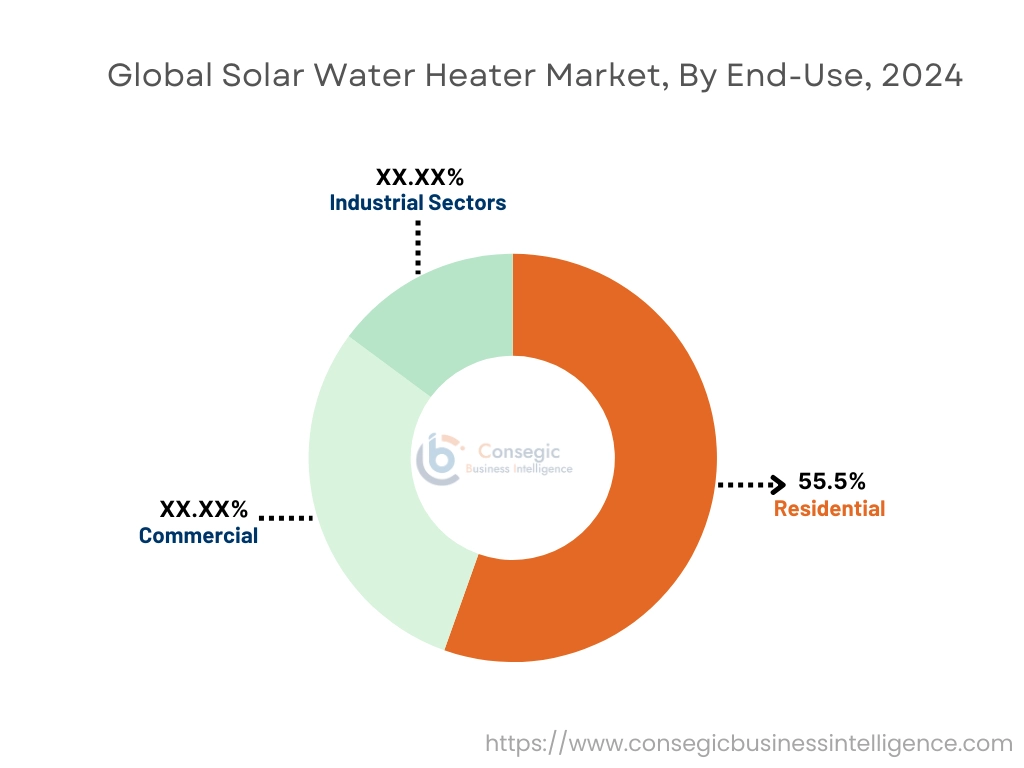
Regional Analysis:
The regions covered are North America, Europe, Asia Pacific, Middle East and Africa, and Latin America.
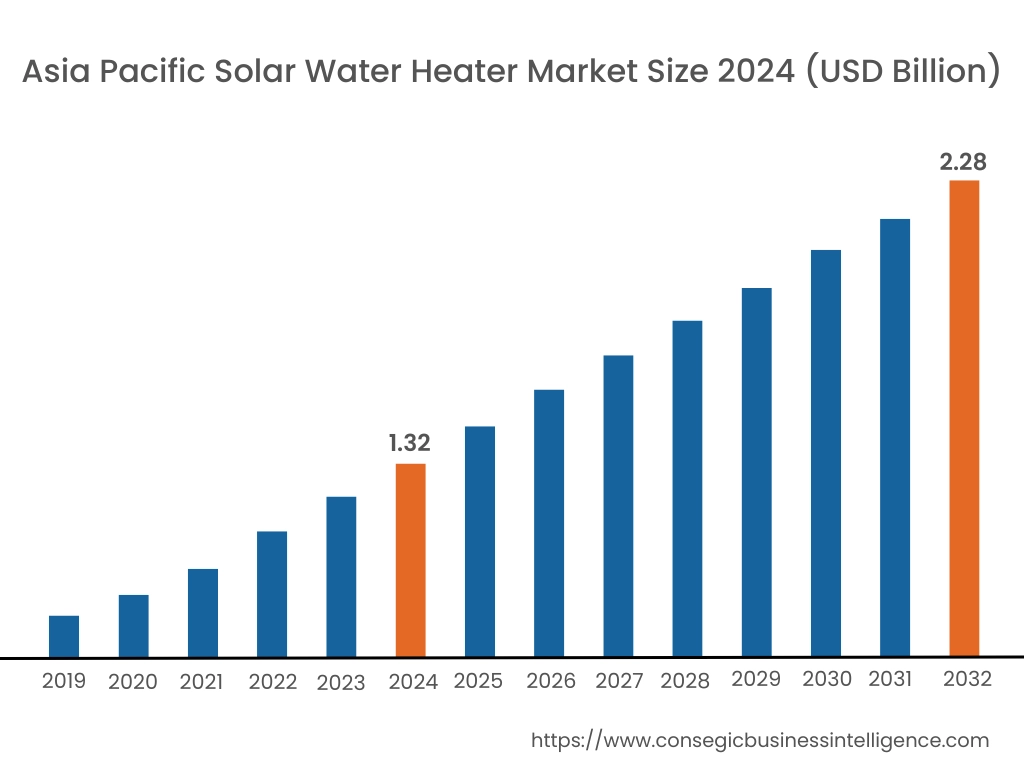
Asia Pacific region was valued at USD 1.32 Billion in 2024. Moreover, it is projected to grow by USD 1.38 Billion in 2025 and reach over USD 2.28 Billion by 2032. Out of this, China accounted for the maximum revenue share of 45.6%.
In the Asia-Pacific region, the drive toward sustainable agriculture and modernized urban infrastructure is influencing the adoption of solar water heaters. The shifting trend towards the local development of robust systems in countries like China and India, where smart-sensor integration enhances irrigation efficiency and water heating performance under diverse climatic conditions is propelling market growth. Furthermore, another trends focuses on the use of advanced materials and adaptive designs to improve the durability of solar collectors in regions such as Japan and South Korea.
- For instance, a report published by Statista states that, in 2023, China was the largest consumer for solar energy with a 35.6 percent share of the total global solar consumption worldwide.
Analysis of the market showed that proactive governmental initiatives and local innovation in green technologies are pivotal to significantly drive the solar water heater market growth.
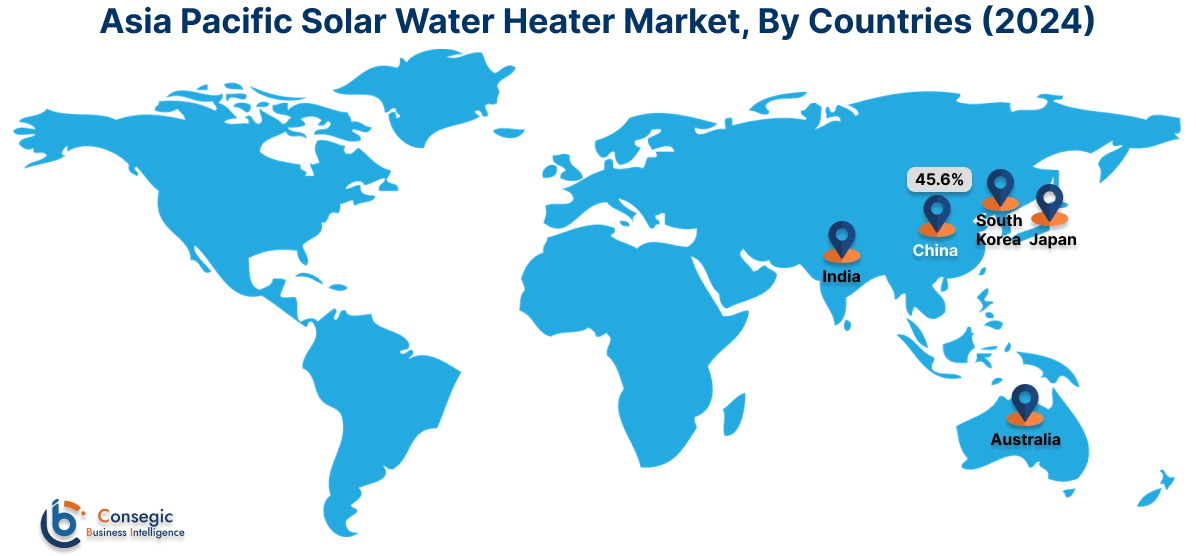
North America is estimated to reach over USD 2.76 Billion by 2032 from a value of USD 1.62 Billion in 2024 and is projected to grow by USD 1.70 Billion in 2025.
In North America, the market is influenced by the rising trend in integrating renewable energy solutions within residential and commercial spaces. The adoption of comprehensive these water heater systems that leverage smart sensor technology for optimal water heating in regions like California and Ontario fuels market development. Additionally, another trends focuses on the use of hybrid systems that combine solar energy with conventional heating to offer reliable performance during varied weather.
- For instance, in April 2024, Naked Energy signed a manufacturing contract with ELM Solar of ELM Companies, leading to a $3 million investment to manufacture the Naked Energy’s Virtu product range. ELM Solar also handles the North American distribution of VirtuPVT and VirtuHOT collectors.
As per the regional analysis, the supportive policies and collaborative innovation among manufacturers and end users are key drivers and the continuous research and development in energy efficiency, significantly drive the smart crop mobility industry in this region.
Europe holds a significant market share due to the sustainability concerns and strict environmental regulations leading to advanced solar water heater solutions that align with eco‑friendly living. In countries such as Germany, Italy, and Spain, where green energy incentives encourage technology adoption, the deployment of high‑efficiency solar thermal panels is growing. Moreover, another trend involves the integration of digital monitoring and automation into solar water heating systems, enabling precise control over energy use, significantly boosting the solar water heater market growth in this region.
The solar water heater market in the Middle East and Africa the focus on environmental sustainability and resource conservation is growing. The shifting trend towards the customization of solar water heating systems designed to withstand extreme temperature fluctuations and limited water resources, particularly in areas like the United Arab Emirates and South Africa drives the market. Moreover, the integration of digital control interfaces that allow for precise monitoring and optimization of water heating processes in harsh environments and the international partnerships adapting advanced water heating technologies, further boost the industry growth.
In Latin America, the increasing adoption of water heater systems powered by the sun’s energy as a part of broader efforts to modernize agricultural practices and improve energy efficiency can be seen in many countries in this region. Additionally, the implementation of solar water heaters in urban centers such as Brazil and Mexico, aimed at reducing reliance on fossil fuels while promoting sustainable practices in residential and institutional settings drives market progress. Moreover, the market analysis shows that focus on the integration of digital and sensor-based technologies into solar water heaters, enabling real-time control over heating processes have significantly driven the solar water heater market expansion.
Top Key Players and Market Share Insights:
The Solar Water Heater Market is highly competitive with major players providing products and services to the national and international markets. Key players are adopting several strategies in research and development (R&D), product innovation, and end-use launches to hold a strong position in the global Solar Water Heater Market. Key players in the Solar Water Heater industry include -
- O. Smith (United States)
- Rheem Manufacturing Company (United States)
- Bosch Industriekessel GmbH (Germany)
- Ariston Holding N.V. (Italy)
- Naked Energy B.V. (United Kingdom)
- Racold Thermo Ltd. (India)
- SunTank Solar Geysers (South Africa)
- Solahart Industries Pty Ltd. (Australia)
- Alternate Energy Technologies, LLC (United States)
- Viessmann Group (Germany)
Recent Industry Developments :
Mergers and Acquisitions:
- For instance, in December 2024, Haier Smart Home Co., Ltd. completed the acquisition of Electrolux South Africa Proprietary Limited (ESA), subsidiary of Electrolux Group that specializes in water heating solutions in South Africa. This acquisition will help Haier in expanding its product range in South Africa.
Partnerships and Collaborations:
- In December 2023, EON partnered with Naked Energy, a UK-based innovator in solar energy solutions. The agreement enables EON to integrate Naked Energy’s solar technology specifically VirtuPVT and VirtuHOT collectors into its commercial and residential offerings. These systems provide solar-heated water and electricity from a single modular unit, making them especially suitable for urban buildings with limited roof space.
Solar Water Heater Market Report Insights:
| Report Attributes | Report Details |
| Study Timeline | 2019-2032 |
| Market Size in 2032 | USD 8.29 Billion |
| CAGR (2025-2032) | 6.9% |
| By Type |
|
| By Collector Type |
|
| By End-Use |
|
| By Region |
|
| Key Players |
|
| North America | U.S. Canada Mexico |
| Europe | U.K. Germany France Spain Italy Russia Benelux Rest of Europe |
| APAC | China South Korea Japan India Australia ASEAN Rest of Asia-Pacific |
| Middle East and Africa | GCC Turkey South Africa Rest of MEA |
| LATAM | Brazil Argentina Chile Rest of LATAM |
| Report Coverage |
|
Key Questions Answered in the Report
How big is the Solar Water Heater Market? +
Solar Water Heater Market size is estimated to reach over USD 8.29 Billion by 2032 from a value of USD 4.86 Billion in 2024 and is projected to grow by USD 5.11 Billion in 2025, growing at a CAGR of 6.9% from 2025 to 2032.
What specific segments are covered in the Solar Water Heater Market? +
The Solar Water Heater Market specific segments for Type, Collector Type, End-Use, and Region.
Which is the fastest-growing region in the Solar Water Heater Market? +
Asia pacific is the fastest growing region in the Solar Water Heater Market.
What are the major players in the Solar Water Heater Market? +
The key players in the Solar Water Heater Market are A. O. Smith (United States), Rheem Manufacturing Company (United States), Bosch Industriekessel GmbH (Germany), Ariston Holding N.V. (Italy), Naked Energy B.V. (United Kingdom), Racold Thermo Ltd. (India), SunTank Solar Geysers (South Africa), Solahart Industries Pty Ltd. (Australia), Alternate Energy Technologies, LLC (United States), Viessmann Group (Germany), and others.
